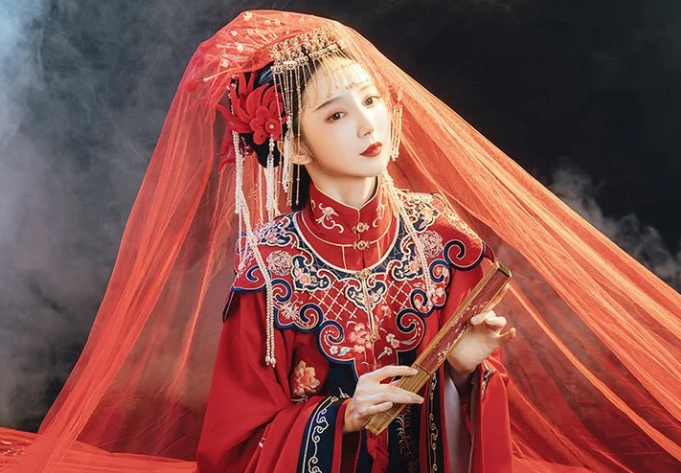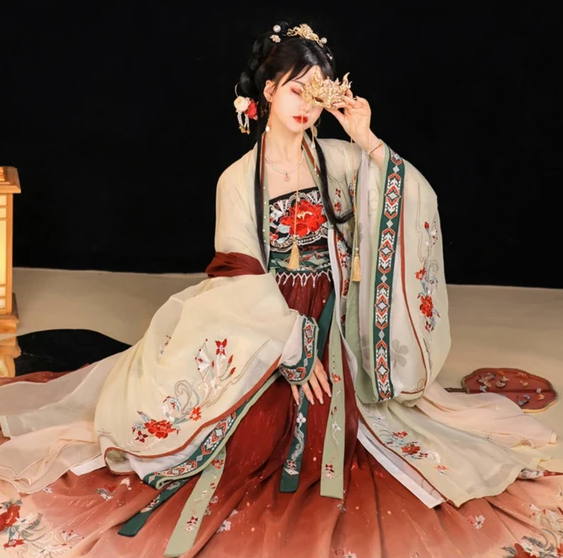Unique Hanfu embroidery styles blend historical motifs with regional variations.
Overview of Hanfu Embroidery
Hanfu, the traditional attire of the Han Chinese people, has been a symbol of Chinese culture for millennia. The embroidery on Hanfu is not just a form of decoration but a rich tapestry of history and symbolism, woven into the very fabric of Chinese society. This art form represents a fusion of aesthetic beauty and cultural significance, making each piece of embroidered Hanfu a story in itself.
Defining Characteristics of Hanfu Embroidery
The embroidery on Hanfu is distinguished by its intricate designs and vibrant colors. Using a variety of stitches and techniques, artisans create patterns that are both visually stunning and rich in meaning. From the fine silk threads to the incorporation of gold and silver filaments, the materials used are as significant as the patterns they form. Traditional motifs often include dragons, phoenixes, flowers, and landscapes – each carrying its own cultural significance and historical narrative. These motifs are not just decorative elements; they are visual representations of philosophical ideas, religious beliefs, and social status.

Historical Significance in Chinese Culture
Tracing back to the earliest dynasties of China, the art of embroidery in Hanfu has evolved through centuries. It has been an integral part of various cultural practices, from royal ceremonies to daily wear of the elite. In the Tang Dynasty, for example, the level of intricacy in Hanfu embroidery was seen as a reflection of one’s social standing. The evolution of embroidery styles over different dynasties also mirrors the changes in Chinese society and politics. It’s a historical record of the shifting tastes and values of Chinese culture.
Hanfu embroidery has also been a medium for cultural exchange. The Silk Road facilitated the exchange of not just goods but also artistic techniques and ideas. This fusion of different cultures is evident in the evolution of Hanfu embroidery, which incorporates elements from other cultures while retaining its uniquely Chinese characteristics.
By understanding the embroidery on Hanfu, one gains insight into the rich tapestry of Chinese history and culture. This embroidery is not just an art form but a visual narrative of China’s past, an unbroken thread that connects the modern world with the ancient. The ongoing popularity of Hanfu and its embroidery in contemporary fashion highlights its enduring appeal and cultural significance.
To explore more about the cultural and historical aspects of Hanfu embroidery, you can visit the Wikipedia page on Hanfu.
Distinct Embroidery Styles in Hanfu
Embroidery, as an integral part of Hanfu, the classical clothing of the Han Chinese, showcases a variety of styles that are not only visually stunning but also culturally rich. Each style embodies the essence of traditional Chinese aesthetics, making Hanfu more than just attire; it’s a canvas for cultural expression.
Silk and Gold Thread Techniques
Gold thread embroider and silk are two of the most prestigious techniques in Hanfu embroidery. Silk, with its lustrous texture and rich colors, provides a vibrant medium for intricate designs. Artisans skillfully weave silk threads to create fluid and dynamic patterns that seem to come alive on the fabric. Gold thread, on the other hand, adds a touch of opulence and luxury. This technique involves the use of fine gold and silver threads, which are meticulously incorporated into the embroidery, often giving the garment a three-dimensional effect. These threads are not only used for their aesthetic appeal but also symbolize wealth and high social status. The combination of silk and gold threads in Hanfu embroidery represents the pinnacle of craftsmanship and elegance in traditional Chinese textile art.
Regional Variations in Embroidery Patterns
The rich tapestry of Chinese culture manifests distinctively across various regions, each contributing uniquely to the art of Hanfu embroidery. To fully appreciate these differences, let’s delve into a comparative analysis, highlighting the regional embroidery styles and their defining characteristics.
Below is a detailed table comparing various regional embroidery styles in Hanfu:
| Region | Embroidery Style | Key Characteristics | Typical Motifs | Cultural Significance |
|---|---|---|---|---|
| Suzhou | Suzhou Embroidery | Known for its subtlety and elegance, Suzhou embroidery boasts fine, delicate stitches and a soft color palette. | Common motifs include flowers, birds, and natural landscapes. | Reflects the gentle, refined culture of the Jiangnan area, emphasizing harmony and nature. |
| Guangdong | Guangdong Embroidery | Characterized by bold colors and dramatic designs, this style is more vivid and expressive. | Features more geometric patterns and bold imagery, like dragons and phoenixes. | Represents the vibrant and dynamic culture of southern China, symbolizing prosperity and vitality. |
| Sichuan | Shu Embroidery | Known for its smooth texture and use of bright, contrasting colors. | Includes a variety of animals, especially pandas, and rich floral patterns. | Embodies the diverse and rich cultural heritage of Sichuan, highlighting the region’s natural beauty. |
| Hunan | Xiang Embroidery | Distinguished by its rugged and bold style, often incorporating thicker threads and strong hues. | Commonly depicts historical stories and local legends, often featuring tigers and lions. | Captures the bold spirit of Hunan and its rich historical narratives. |
This table presents a vivid contrast of regional embroidery styles in Hanfu, underscoring the diversity within Chinese cultural expression. Each region’s embroidery style not only showcases unique aesthetic qualities but also embodies deep cultural and historical significance. These variations are a testament to the rich, multifaceted nature of Chinese embroidery art. For further exploration into these regional styles, Wikipedia’s page on Chinese embroidery provides extensive information.
https://www.youtube.com/watch?v=IYb3KtzholY&pp=ygUvV2hhdCBhcmUgdGhlIHVuaXF1ZSBlbWJyb2lkZXJ5IHN0eWxlcyBpbiBIYW5mdT8%3D
Symbolism in Hanfu Embroidery
Hanfu embroidery, an art form steeped in Chinese tradition, serves as a vivid storyteller of China’s rich cultural heritage. This intricate craft goes beyond mere aesthetics; it embodies a deep symbolism that has been passed down through generations.
Floral and Faunal Motifs
Floral and faunal motifs stand as a testament to the profound symbolism inherent in Hanfu embroidery. The lotus flower, for instance, emerges as a symbol of purity and spiritual enlightenment, deeply rooted in Buddhist ideology. Peonies, with their lush and full blooms, represent wealth and prosperity, mirroring the desires and aspirations of ancient Chinese society. Chrysanthemums, known for their resilience, symbolize longevity and the enduring nature of life.
In the realm of faunal motifs, the dragon commands attention as a symbol of power and auspiciousness, a key figure in Chinese mythology. The phoenix, often depicted alongside the dragon, signifies grace and the harmonious balance of yin and yang. Cranes, revered for their long life, become emblems of longevity and peace. These motifs do more than just decorate; they communicate a language of symbols, deeply intertwined with the cultural and spiritual beliefs of China.
Imperial and Religious Symbols in Embroidery
Imperial and religious symbols in Hanfu embroidery reflect the profound intertwining of state power and spiritual beliefs. The imperial dragon, with its five claws, was a symbol exclusive to the emperor, signifying absolute power and divine rule. The strict regulation of these symbols underscores their importance in the hierarchical and ceremonial fabric of ancient China.
Religious symbols in Hanfu embroidery draw from the rich tapestry of Buddhism, Taoism, and Confucianism. The Taoist yin-yang, symbolizing balance and harmony, finds its place in this art form. The Buddhist endless knot represents the eternal cycle of life, a core concept of Buddhist teachings. Confucian symbols, more subtle yet equally significant, like the plum blossom, stand for resilience and moral integrity, echoing the teachings of Confucius.
Through Hanfu embroidery, we gain insight into China’s imperial past and its religious philosophies. These symbols serve not only as artistic expressions but also as a narrative of China’s rich and complex history. The art of Hanfu embroidery thus becomes a bridge connecting the past with the present, keeping the stories and traditions of ancient China alive. For more insights into these symbols, the Wikipedia page on Chinese symbolism is an excellent resource.

Contemporary Interpretations and Techniques
The art of Hanfu embroidery, with its deep roots in ancient Chinese culture, is experiencing a dynamic renaissance in the modern era. Contemporary artists and designers are not only preserving this traditional art form but are also reinterpreting it, blending ancient techniques with modern aesthetics.
Modern Adaptations of Traditional Embroidery
Modern adaptations of traditional Hanfu embroidery are creating a unique fusion of the old and the new. Contemporary designers are experimenting with new materials and techniques while honoring the traditional motifs and patterns. For example, eco-friendly dyes and synthetic fibers are being incorporated to enhance durability and colorfastness, making these garments more suitable for modern lifestyles. Innovations in embroidery techniques, such as 3D embroidery and digital design, are being embraced to create more intricate and bold patterns. These modern adaptations are not just about aesthetics; they represent a bridge between the rich heritage of Hanfu and the contemporary fashion world. Designers are creatively interpreting traditional symbols and motifs, giving them a fresh perspective that resonates with today’s audience.
Influence of Hanfu Embroidery in Contemporary Fashion
The influence of Hanfu embroidery in contemporary fashion is becoming increasingly evident. High-fashion designers are incorporating elements of Hanfu embroidery into their collections, showcasing them on international runways. This has led to a growing interest in Hanfu and its embroidery techniques among fashion enthusiasts worldwide. The unique blend of intricate embroidery, rich symbolism, and vibrant colors makes Hanfu embroidery a sought-after element in contemporary fashion design. The global fashion industry is recognizing the value of sustainable and culturally rich textiles, further elevating the status of Hanfu embroidery. This trend is not only reviving interest in traditional Chinese textile arts but is also promoting cultural exchange and appreciation on a global scale.
Through these modern interpretations, Hanfu embroidery is gaining new life and relevance in the contemporary world. It is a testament to the enduring appeal of this ancient art form and its ability to adapt and thrive in a rapidly changing global landscape. For a deeper dive into the evolution of Hanfu embroidery, the Wikipedia page on Chinese embroidery offers comprehensive information.







